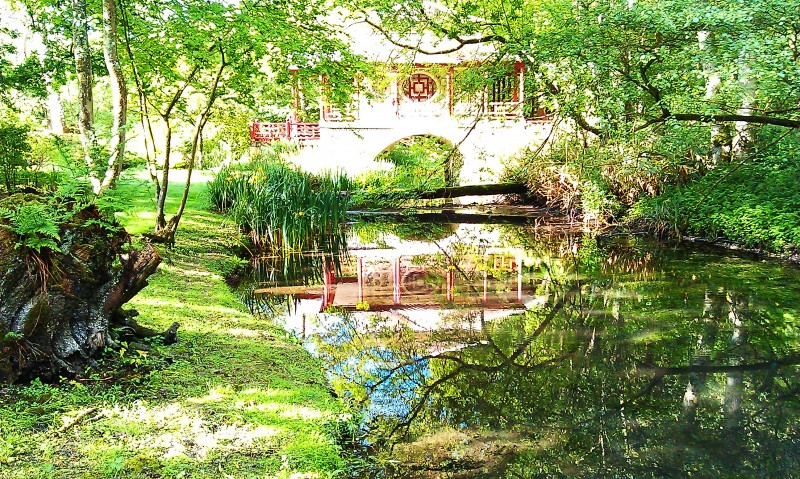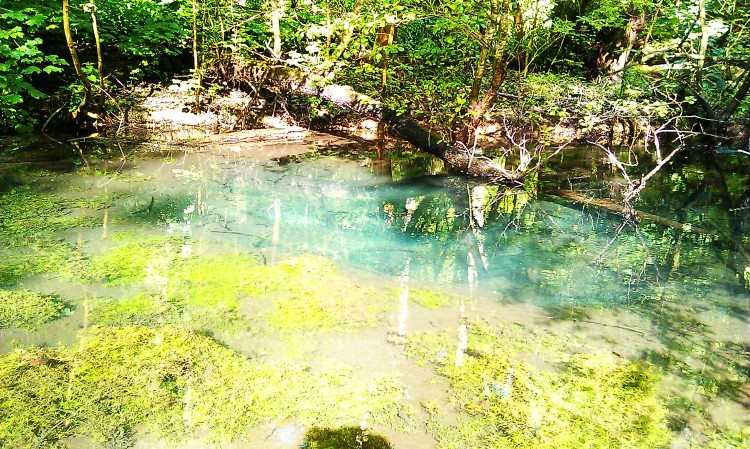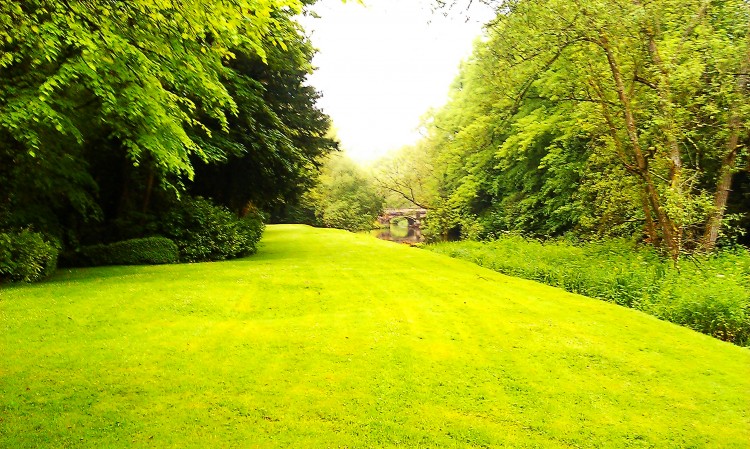The Birds of Amesbury Abbey

WRITTEN BY Austin Kinsley ON 29/05/14. The Birds of Amesbury Abbey POSTED IN Amesbury Abbey Avon River
The above photograph was captured at approximately 7:45am on 22 May 2014 of the morning sun illuminating the Chinese summer house in the grounds of Amesbury Abbey, at the foot of Vespasian’s Camp. The variety and sound of bird song as I approached the River Avon at the foot of the heavily wooded and naturally pristine Vespasian’s Camp was stunning. The summer house sits over a meander that has been cut off from the main flow of the River Avon, the water still in morning sunlight and crystal clear above a settled muddy riverbed. In a number of areas, bubbles of air arose from a fresh water source below the riverbed, gently feeding fresh water into the river. In numerous areas where the bubbles were arising, the water took on a turquoise/azure phosphorescent hue. An image is attached below of this enchanting feature. The far side of the riverbank is the foot of Vespasian’s Camp, oozing a jungle of truly wildlife sounds that morning.
During 1984, Mrs. R.L. Howells made 35 visits to the Abbey grounds and recorded — as she emphasised at the time — ‘only a small cross-section of the bird activity that must have taken place’. Most of the visits took place in spring and early summer. Subsequent visits were made in every month of the year with the exception of July. The report mainly covers the parkland and woodland surrounding the Abbey, together with the riverside and woodland walk to the Chinese summer house. Observations were also made from the fields on either side of the Abbey drive, the fields across the river and the woodland of Vespasian’s Camp. Over the course of these visits, Mrs. Howells recorded 64 species of birds, and below is an extract of the record she meticulously compiled:
- Little grebe…Quite numerous, seen on 14 visits, no evidence of breeding.
- Grey heron…One seen feeding immediately below Queensbury Bridge early morning on 16 September.
- Mute Swan…A breeding pair in the reed bed close to the Chinese summer house and 7 cygnets between 27 March and 19 May.
- Canada goose…Two overflew the Abbey grounds on 6 May.
- Mandarin duck…A male seen on 16 September and 13 October.
- Mallard duck…Noted on most visits, 3 or 4 pairs ducklings noted on 3 May and 5 May.
- Teal…Male on the river 16 December.
- Pochard…A male and 2 females on 1 April. 2 males and 3 females on 3 April.
- Tufted duck…5 pairs on river 20 April and smaller numbers on other dates until the end of April. 16 on 13 August.
- Sparrowhawk…3 April a female flying south. One flying east on 14 April and overhead on 12 May.
- Buzzard…Soaring over Amesbury on 15 May.
- Kestrel…The commonest raptor seen on six occasions…A Kestrel for a Knave.In medieval England the only bird a knave was legally allowed to keep.
- Pheasant…Often seen in the riverside meadows. Rearing takes place in Vespasian’s Camp, but some also breed wild.
- Water rail…One flew across the river at Bowles Hatches on 1 April.
- Moorhen…A common waterside resident. A pair bred in the backwater by the Chinese summerhouse close to the mute swan’s nest. The nest held 6 eggs. (I noticed a pair in exactly the same area on 22 May 2014, 30 years later).
- Coot…A common waterside resident. At least 3 pairs bred in the Abbey grounds. One nest held 6 eggs, another 7 and a third 10, of which 8 hatched on 16 May.
- Lapwing…Seen occasionally in the fields below vespasian camp woods or flying over the grounds.
- Black headed gull…77 flew south over the Abbey grounds on 1 April, otherwise only seen in small numbers.
- Common gull…2 flew over Abbey grounds on 5 May.
- Lesser black backed gull…6 flew north on the evening of 6 May.
- Feral pigeon…A common resident. Often seen in Abbey drive. Breed in St. Melor church tower.
- Stock dove…A common resident. A pair breeding in the roof of the Chinese summerhouse.
- Wood pigeon…A very common resident, often seen feeding in waterside meadows. Numerous in vespasians camp woodland where they form large roosts.
- Collared dove…A pair seen on 21 May.
- Cuckoo…Heard calling on 26 April and 14 May.
- Tawny owl…One heard calling in the Abbey grounds in the late evening of 9 May.
- Swift…Only seen in May as ones and twos. Hawked for insects over the Abbey grounds.
- Kingfisher…8 sightings in 6 days between 26 April and 1 May. Most frequent sightings between palladian bridge and Bowles Hatches. A pair were seen together.
- Green woodpecker…Seen or heard yaffling on 11 visits. A pair were seen on 23 April.
- Great spotted woodpecker…Seen or heard drumming on 7 visits. A pair observed mating in the treetops by the palladian bridge.
- Swallow…Often seen hawking for insects over the Avon below Queensbury Bridge and comparatively rare in Abbey grounds. Noted on 3 occasions.
- House martin…Common in Amesbury, only noted on 2 occasions in Abbey grounds.
- Grey wagtail…Noted on 11 occasions. Pair seen prospecting a nest on Bowles Hatches, but moved on.
- Pied wagtail…Common Amesbury resident. Noted 4 times in Abbey ground.
- Wren…A common breeding resident.
- Dunnock…A common breeding resident.
- Robin…A common breeding resident.
- Blackbird…A common breeding resident.
- Redwing…One record of 3 feeding in the meadows alongside the Abbey drive on 3 April.
- Mistle thrush…Particularly common on the corner of the copse near St. Melor church where the drive emerges from the trees.
- Whitethroat…Surprised by the passage of 1 bird by the palladian bridge on 21 April.
- Blackcap…Males seen on 27, 28, 30 April and 5 May. One female seen with a male on 11 May. Most sightings in riverside scrub. A possible breeder.
- Chiffchaff…Noted throughout April and May, with as many as 3 singing at any one time. Almost certainly breeding.
- Willow warbler…First noted on 23 April. Also seen on 27 April and 5 May. Likely to be passage birds only.
- Goldcrest…Recorded on most visits. A common breeding resident. Most often seen or heard on the woodland walk to the Chinese summer house.
- Spotted flycatcher…Seen on 3 occasions. May have bred near gardeners greenhouse. First seen on 28 April.
- Long tailed tit…Noted on 10 occasions, often near the Chinese summer house or in riverside scrub. A probable breeder.
- Willow tit…One heard and briefly seen in the woodland of Vespasian’s Camp on 21 April.
- Coal tit…Fairly common breeding resident, most often seen in the specimen trees between the Abbey and palladiun bridge.
- Blue tit…Common breeding resident. Often seen in riverside scrub.
- Great tit…Not as common as the blue tit, but a common breeding resident.
- Nuthatch…Noted on 5 occasions, usually in the trees between the Abbey and palladiun bridge. Probably breeding.
- Treecreeper…Recorded on 6 occasions, probably breeding near the river. A pair seen twice in the shrub just to the right of the approach to the palladian bridge.
- Jay…2 records. Singles in the woodland near Bowles Hatches on 3 April and 1 May.
- Magpie…Often seen and heard in the Abbey grounds and adjoining woodland. Believed to have bred in Vespasian’s Camp.
- Jackdaw…Common breeding resident. Often seen on the Abbey roof.
- Rook…Common breeding resident. Some 40 nests in the trees around the entrance to the Abbey drive.
- Carrion crow…Often seen flying over but comparatively rare on the ground.
- Starling…Common breeding resident. A pair feeding noisy chicks in a tree near Bowles Hatches on 1 May. Nest hole 30 feet above ground level.
- House sparrow…Common breeding resident. Often seen around the Abbey.
- Chaffinch…A very common breeding resident. At least one pair bred near the mews.
- Greenfinch…Very common breeding resident usually seen in the cypresses and other trees by the front of the Abbey.
- Bullfinch…1 sighting, a male in riverside hawthorns on 27 April.
- Yellowhammer…1 record of a single male heard from the woodland on 8 June.
Lady Florence Caroline Mathilde Antrobus in a forward to the sale document of Amesbury Estate in 1915 consisting of 6240 acres (and including Lot 15 Stonehenge) wrote:
‘The name Ambesbury, signifying according to some authorities ‘The land of Ambrosius’, a Brito-Roman general who came invited over by Vortigern, to assist in expelling from Britain the barbarous Saxons. Upon the death of that monarch he was proclaimed king of Britain. He (Aurelianus Ambrosius) died at Winchester Anno 508. There is a carved head on the north side of the nave of Amesbury church — a typical Roman countenance — which is most likely his portrait.’
and:
“I consider credence should be placed in the idea that a great Druidical ‘Cor’ (choir or sanctuary) or college once occupied the site of the Christian Abbey – a kind of Oxford I think for the education of the Druidical priesthood. The British druids were Celts, and consequently a highly cultivated civilised race.”
Lady Antrobus enjoyed an intimate knowledge and understanding of the Abbey, its grounds and atmosphere, as it was her family home for many years.
For me, the single word that captures these pristine grounds is ‘enchanted’.
My heartfelt thanks to the Cornelius Reid family as ever.
RSPB here.























